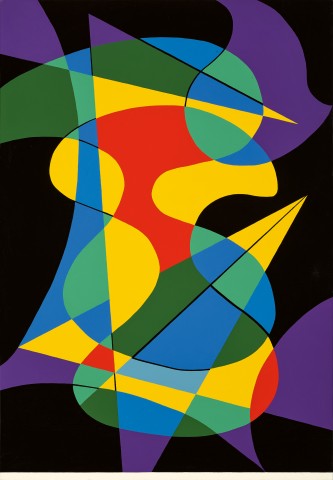GONE BIO-BIO TOO, 1993
ROBERT ROONEY
synthetic polymer paint on canvas
177.5 x 122.0 cm
signed, dated and inscribed with title verso: ROBERT ROONEY / << GONE BIO–BIO TOO >> / 1993.
Pinacotheca Gallery, Melbourne
The National Australia Bank Art Collection, acquired from the above in October 1999 (label attached verso)
Robert Rooney, Pinacotheca Gallery, Melbourne, 29 September – 16 October 1993, cat. 7
Joan and Peter Clemenger Triennial Exhibition of Contemporary Australian Art, National Gallery Victoria, Melbourne, 15 March – 1 May 1996 (label attached to stretcher bar verso)
McPhee, J., Joan and Peter Clemenger Triennial Exhibition of Contemporary Australian Art, National Gallery of Victoria, Melbourne, 1996, p. 27 (illus.)
Robert Rooney is often lumbered with the blanket description that he was one of Australia’s finest conceptual artists. While somewhat accurate it is nonetheless an incomplete catch-all to describe work which is diverse but solidly underpinned conceptually. Consider Sol LeWitt’s proposition: ‘In conceptual art the idea or concept is the most important aspect of the work. When an artist uses a conceptual form of art, it means that all of the planning and decisions are made beforehand and the execution is a perfunctory affair’.1 It is not possible to look at anything Rooney has undertaken and fail to be impressed by the ‘hand’ of the artist at every stage.
The Field exhibition of 1968 consisted largely of colourfield formalism while Rooney’s contribution, a painting of richly multi-coloured uniform shapes and repeated within a gridded system, was deservedly highlighted for its originality and avant-garde credentials: but despite the context, his works were Pop art.2 His consistency was always unwavering, ‘I have always preferred to work from secondary sources, particularly mass media ones, rather than paint or draw from the actual subject’.3 The Kind-hearted kitchen-garden series from 1967 – 68 remain highly regarded. His discreet and underplayed wry humour was always present. Some shapes have their origins in packets of Kellogg’s cornflakes – the back of the packet and the cardboard components were able to be removed and assembled for a child’s amusement.4 Rooney straddles two bridges, that of a Pop artist and one who is central to Post-Pop in Australia. A friend to many of the next generation and a co-exhibitor with them, he was the oldest participant in the landmark exhibition Popism.5
In 1970, he abandoned painting and didn’t begin again until 1982. The intervening years were intensely productive; photography took over. His distinctive approach with an interest in conceptualism, serialisation, repetition – usually deadpan in character – invoked imagery from home to suburbia. It began a correspondence and relationship with an international network of like-minded artists from Los Angeles to New York and London.
When Gone Bio–Bio Too was exhibited at the Joan and Peter Clemenger Triennial Exhibition of Contemporary Australian Art in 1993, Rooney offered the briefest of statements, recalling his early interest in abstraction, cubism and surrealists such as Jean Arp and Joan Miró, ‘…also take on associations with my hard-edge serial/cereal abstractions of the late 1960s. Other associations will have to be worked out by the viewer.’6 The reference to biomorphic abstraction is unmistakable, especially Miró where organic bulbous shapes are divided by two contrasting colours and black lineal definitions play across the surface.7 Rooney often used imagery he had gathered from childhood onwards, with the flatness of children’s book illustrations and comics coming to mind. An all-over controlled randomness is evocative of sixties design – sweeps, arcs, and geometric shapes that float are held in space, intersected and lock together. He trained as a commercial designer – a modernist style of his generation that remained with him.
What makes Gone Bio–Bio Too so remarkable is Rooney’s multifaceted play with elusive sources, ideas and interests to make a work which delights with the completely unexpected.
1. LeWitt, S., Paragraphs on Conceptual Art, Artforum Vol. 5, no. 10, Summer 1967, pp. 79 – 83
2. Brophy, P., Robert Rooney as Pop in From the homefront: Robert Rooney, works 1953 – 1988, Monash University Gallery, Melbourne, 1990
3. Quote by the artist, 1986, accompanying the catalogue entry for Child's journey 1944 – 1954, 1983, synthetic polymer paint on canvas, collection of Museum of Contemporary Art, Sydney, gift of Loti Smorgon AO and Victor Smorgon AC
4. Kind-hearted kitchen-garden IV, 1968, synthetic polymer paint on canvas, 168.0 x 168.0 cm, collection of The University of Melbourne Art Collection, Melbourne
5. Popism, National Gallery of Victoria, Melbourne, 1982, curated by Paul Taylor (1957 – 1992), former editor of Art & Text. Artists featured in the show included Howard Arkley, David Chesworth, Ian Cox, Juan Davila, Richard Dunn, Paul Fletcher, Maria Kozic, Robert Rooney, Jane Stevenson, The Society for Other Photography, Imants Tillers, Peter Tyndall, Jenny Watson, and Tsk Tsk Tsk.
6. Rooney cited in Joan and Peter Clemenger Triennial Exhibition of Contemporary Australian Art, National Gallery of Victoria, Melbourne, 1993, n.p.
7. Joan Miró (1893 – 1983), Hirondelle Amour 1933 – 34, oil on canvas, Museum of Modern Art, New York, gift of Nelson A. Rockefeller, 1976
DOUG HALL AM
